As an Amazon Associate, we earn from qualifying purchases with no additional costs for you.
A pocket knife is the epitome of an EDC knife. It is designed to be carried in your pocket to be available at any time for any task that may arise where it could be useful. You may have your pocket knife with you at all times, but you may not have sharpening tools with you at all times to keep your knife sharp. Follow our six best ways of sharpening your pocket knife both with a stone and without.
Here is our selection of the six best methods to sharpen a pocket knife with and without a stone.
- Diamond stone. Good but expensive.
- Whetstone. Good option.
- Honing rod. Only on a good edge.
- Files. Requires extra care.
- A rock. A method for the backcountry.
- Sandpaper. A good alternative.
The best method to sharpen your pocket knife is with dedicated workbench-top tools to put a fine-tuned edge on the blade. However, the portability of the pocket knife means you may not have these tools available to touch up or sharpen your knife as needed. We will discuss some of the ways you can sharpen your pocket knife wherever you may be.
If you are interested in checking out the best sharpeners for pocket knives we recommend and use you can find them by clicking here (Amazon link).

What Can You Sharpen A Pocket Knife With?
Most of us have all heard the expression that a dull knife is a dangerous knife, and this is true because you need to apply more pressure to force a dull knife to cut. This additional force increases the risk of the blade slipping and injuring the user.
This truth is particularly important for your pocket knife, the knife you will reach for most frequently when you need a blade.
When the need arises, and you reach into your pocket for your trusty pocket knife, the knife should be sharp and ready for action. Keeping a pocket knife sharp can be more challenging than other knives simply due to how frequently the knife is used.
A pocket knife can be sharpened using any method used to sharpen other knives, but these methods are not always practical out in the field or portable enough to take along with you wherever you go.
Many sharpening methods have been designed to overcome this problem for pocket knife owners, allowing you to keep your pocket knife as sharp as possible.
Some methods are intended to do a proper sharpening and restore the edge, while others are intended to touch up an already sharp edge and simply improve the keenness of the edge.
We will discuss all these methods for pocket knife sharpening to give you insight into the best methods you can use to keep your pocket knife blade primed and ready for anything!
How To Sharpen A Pocket Knife With A Stone
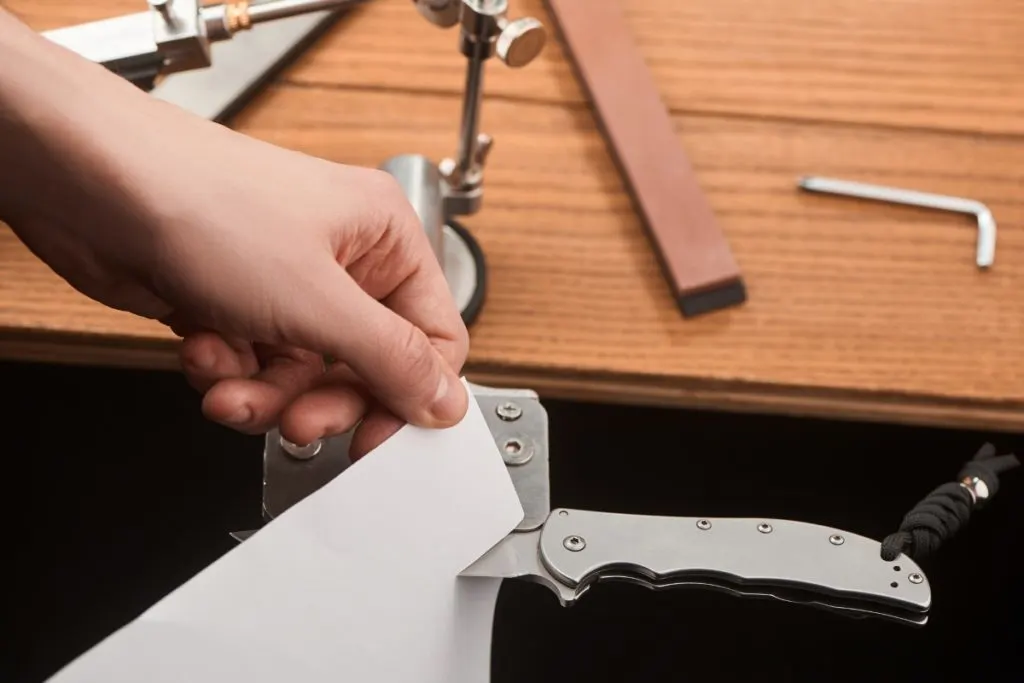
Whetstones are the sharpening method that comes to mind when knife sharpening is mentioned. Most whetstone sharpening methods, whether using water stones, oil stones, diamond stones, or ceramic stones, are generally considered workbench sharpening methods.
This means that you need a work surface to perform the sharpening activity since you need the stability of a solid surface on which to work.
Despite the space and logistic requirements for whetstone methods, they are the most effective methods for repairing, maintaining, and sharpening the edge of your pocket knife.
PRO TIP: We personally use diamond plates by Atoma. They are quite expensive but of the top quality with very long service life.
The initial costs are higher but you have an option of buying replacing diamond skin for all Atoma plates. The costs of replacing diamond skin are much lower than the cost of buying a new diamond plate.
So if you are going to use diamond plates regularly and want to get the best quality on the market, check out the four Atoma diamond plates listed below (Amazon links).
- Atoma Diamond Sharpener Coarse Grade 140 Grit
- Atoma Diamond Sharpener Medium 400 Grit
- Atoma Diamond Sharpener Fine 600 Grit
- Atoma Diamond Sharpener Super Fine 1200 Grit
These 4 diamond sharpening stones are all you need to have for repairing or sharpening your knives.
Using A Diamond Stone
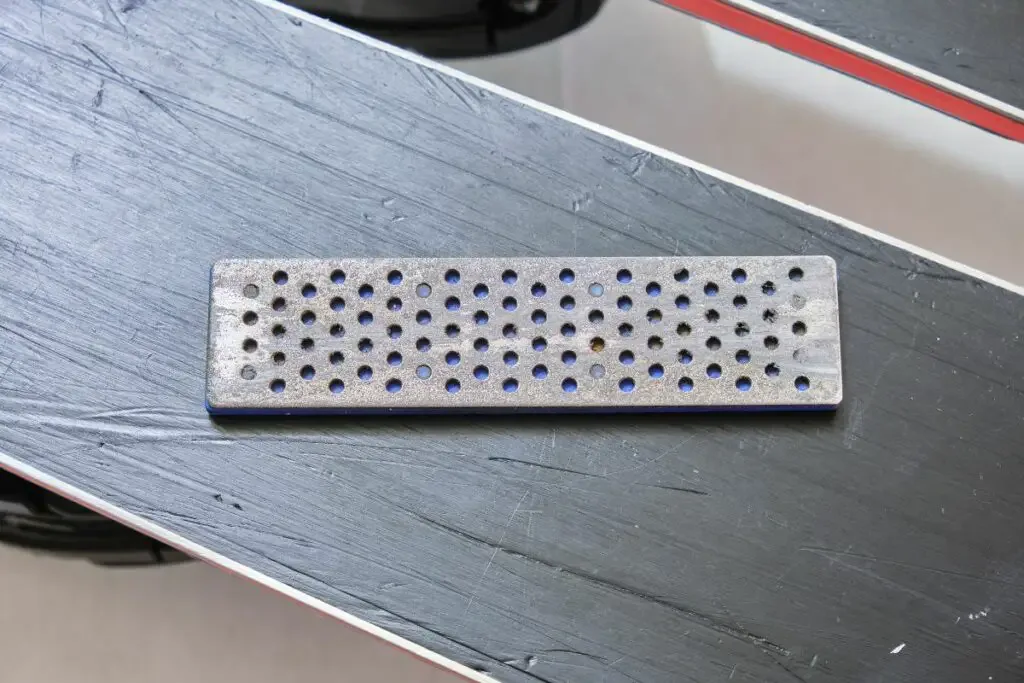
Diamond stones are one form of whetstone sharpening you can use to sharpen your pocket knife. There are several advantages that diamond stones offer over other whetstone forms.
Diamond stones offer excellent cutting ability to sharpen the edge, particularly on stainless steel knives that are difficult to sharpen due to the wear resistance of the steel.
Although it is not ideal, diamond stones can be used without any lubrication, but it is preferred to use water on these stones while sharpening. The ability to use the stones dry offers more portability and less mess when sharpening.
To sharpen your pocket knife on a diamond stone, follow these technique guidelines.
- Use a level surface. Place the diamond stone on a firm, level surface at about elbow height. This will help you stay relaxed while sharpening.
- Find the correct sharpening angle. Place the pocket knife blade flat on the stone, with the sharp edge facing towards you. Slowly lift the knife’s spine towards you until you feel the flat of the secondary bevel makes contact with the stone. This will be your sharpening angle.
- Lubricate the stone. Sprinkle some water on the stone as lubrication.
- Sharpen one side till a burr is raised. Maintaining the correct angle, draw the blade across the stone, covering the blade’s full length. After a few strokes, feel the opposite side of the sharp edge to establish if a burr has been raised. If the burr is present, move on to the next step.
- Sharpen the opposite side. Flip the blade over, this time with the sharp edge away from you. Find the angle and draw the knife towards you across the stone, once again ensuring the entire length of the knife makes contact with the stone.
- Move up a grit level. Move up to a higher grit stone and repeat the process on each side.
- Finish with a high grit stone. To put a final polish on the cutting edge, finish with your highest grit stone or with a leather strop.
Diamond stones are a great pocket knife sharpening option, and you can obtain smaller-sized diamond stones for portability. The main disadvantage of diamond stones is the cost. Diamond stones are generally more expensive than most other whetstone options, with ceramic or glass stones the only exception.
You will need a progression of grits in diamond stones to properly sharpen your pocket knife. For fixing and repairing an edge, we recommend a 250-grit diamond stone. Start with a 600-grit, then move to a 1000-grit stone for the sharpening process. A 1200-grit stone works well as a finishing or polishing stone.
TIP: Diamond stones have some benefits that may fit better with your sharpening needs. Check out the complete guide on how to use diamond stones in the article below:
DIY Guide: Using Diamond Knife Sharpening Stone Like A PRO
Using A Whetstone
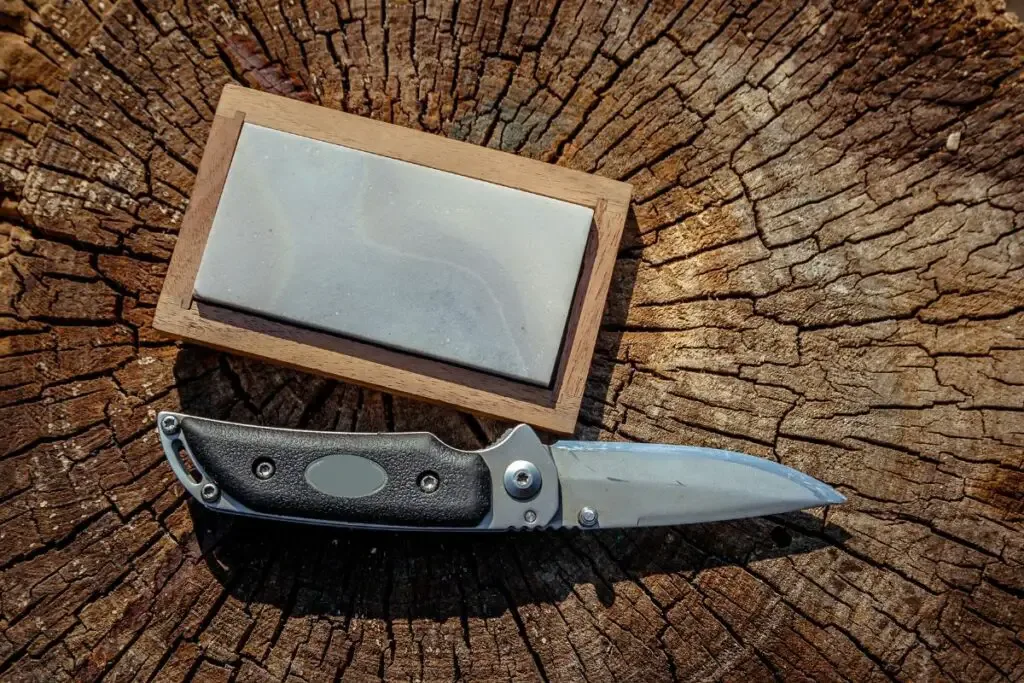
A whetstone is any abrasive “stone” that can be used to sharpen a knife. The word “whet” is an old English word that means “to sharpen.”
Since we have already covered diamond stones, which are also whetstones, our current topic will include other options, such as water stones and oil stones.
These stones are more affordable but are also generally considered a workbench-type sharpening system.
Depending on the stone type, whetstones require an appropriate lubricant, either water or oil. The process of using a whetstone to sharpen your pocket knife is the same as you would use on a diamond stone.
The key aspects of sharpening on a whetstone crucial to establishing a good edge are as follows.
- Establish the sharpening angle. This is the most important aspect to get right in the sharpening process.
- Maintain the angle throughout the stroke. Keeping the correct angle throughout the sharpening stroke of the blade across the stone is the second most important part of the process.
- Raise a burr on one side. Sharpen one side till you feel the burr raised across the entire length of the blade.
- Change sides and raise a burr. Once a burr is raised on one side, turn the knife over and repeat on the opposite side.
- Increase the grit level. Work through the grits till the knife is sharp.
- Finish the edge on a polishing stone and a strop. Make your final passes of the knife across the stone with a high grit and finish the edge off on a leather strop.
While the mechanical process of using a whetstone is the same as using a diamond stone, the grit levels work a little differently.
A 320-grit whetstone is a good grit for repairing a damaged edge on your pocket knife. For sharpening, we recommend starting at 400-grit for a very dull knife or 600-grit for a knife with a better edge. Progress to a 1000-grit stone.
Finish the sharpening process by honing the edge on a 6000-grit stone and finally give it a light strop using a leather strop with a polishing compound.
TIP: Are you looking to buy a new whetstone? Check out our recommendations (we personally use the first three ones):
Our PRO choice whetstones combo (Amazon links):
- Fixing stone: Whetstone SHAPTON Ceramic KUROMAKU #320
- Sharpening stone: Suehiro CERAX soaking whetstone: Medium #1000
- Finishing stone: Whetstone SHAPTON Ceramic KUROMAKU #5000
Our budget choice (Amazon link): Sharp Pebble Extra Large Sharpening Stone Set
TIP: We have put together some options that we believe offer you the best sharpening solution for your pocket knife. Check them out in the article below:
The 4 Best Knife Sharpeners For Pocket Knives
How To Sharpen A Pocket Knife Without A Stone (Sharpener)
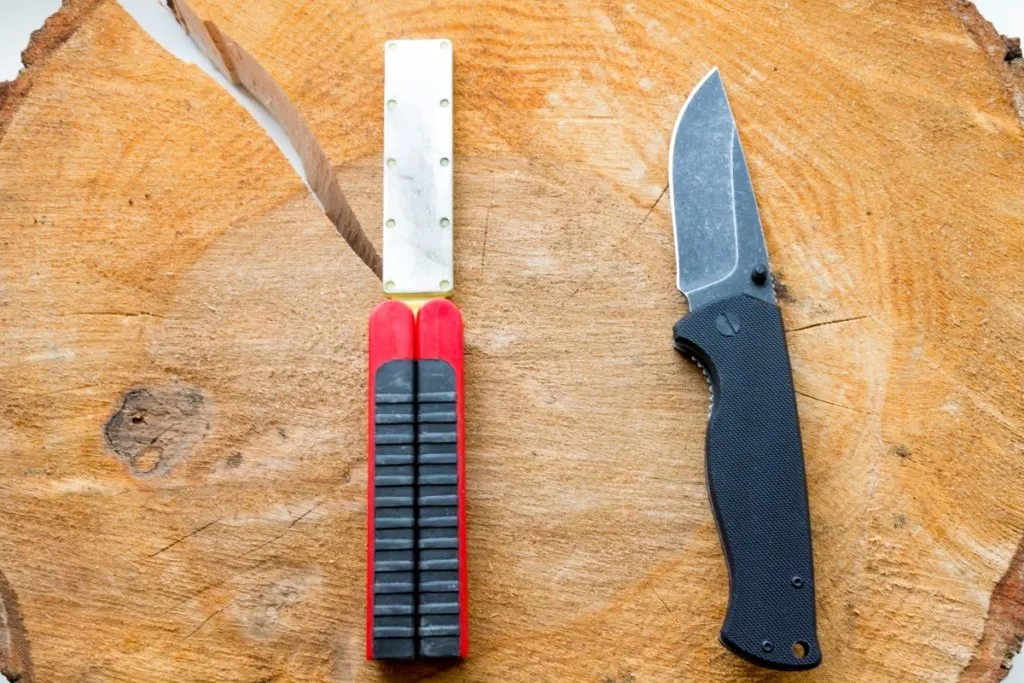
Whetstones are a great method to sharpen a pocket knife, but they are not always the most practical. You can use several other methods to re-establish the edge on your pocket knife and restore it to working condition.
We will cover some of these methods to give you alternatives that may be a little more convenient, particularly if you do not have access or time to perform a complete sharpening with whetstones.
How To Sharpen a Pocket Knife With a Rod
A honing rod is an option you can use to quickly restore sharpness to the cutting edge of your pocket knife. Honing rods are sometimes called sharpening steels, although their function is honing the edge rather than sharpening a dull knife.
Honing rods will not have the ability to restore a damaged edge on a knife or sharpen an extremely dull knife. Their function is to fine-tune the edge of a knife that is already pretty sharp.
Most kitchens will have a honing rod for touching up the edge of knives used in the kitchen. These rods can be ceramic, steel, or diamond rods.
Follow these steps to sharpen your pocket knife on a honing rod.
- Place the tip of the rod on a firm surface. Hold the rod’s handle in your non-dominant hand and place the tip of the rod securely on the kitchen countertop. You can protect the countertop surface with a kitchen cloth under the tip. This also helps to stabilize the rod on a slippery surface.
- Get the angle right against the rod. Position the knife blade against the rod at the correct sharpening angle. The best angle for most pocket knives is between 25° and 30°.
- Run the knife edge along the rod. Start at the hilt of the knife and, working towards the tip, run the entire length of the blade’s edge across the rod in one stroke. Not much force should be applied to the knife edge against the rod; otherwise, the edge can be damaged. Perform 2 or 3 strokes on one side on the edge, then repeat on the other side of the edge.
- Direction is important. Never push the cutting edge of the knife into the rod. The direction of the stroke should always be drawing the blade across the steel away from the cutting edge or towards the spine of the knife.
- Check the edge periodically. Test the edge for sharpness after 2 or 3 strokes on each side of the edge. The number of cycles you need to perform will depend on the state of the edge of the knife.
Sharpening your pocket knife in this way will restore the keenness of the edge on your pocket knife, but if more aggressive sharpening is required, one of the other messages would be more appropriate.
TIP: Some pocket knives experience difficulties opening and closing, either when they are new or used over time. Find out the complete DIY guide on fixing pocket knives in the article below:
How To Fix Guide: Open & Close A Pocket (Swiss Army) Knife
How To Sharpen A Pocket Knife With A File
Using files to sharpen a knife is possible, but it requires extreme care to prevent damaging the blade’s edge. You will need a range of files with different levels of coarseness, and single-cut files are the best file type to sharpen a knife.
Place the knife in a vise, securing the handle in the vise. Wrapping a cloth around the handle will help prevent the pocket knife handle from being damaged in the vise.
Ensure the knife blade is facing away from you. The direction you push the file over the knife should always be from the knife’s spine towards the knife’s cutting edge.
Pushing the file into the edge can damage the cutting edge and gouge chunks of steel out of the cutting edge.
Follow the secondary bevel angle with the file and pass the file across the entire length of the blade with very little pressure. Perform 3 to 5 passes of the file over the cutting edge, then turn the knife over and repeat on the opposite side.
Finish sharpening the pocket knife with the finest file you have, and if possible, run the edge over a leather strop a couple of times to refine the edge.
TIP: Can you sharpen your knife with a file and get a good edge? Check out the complete guide on sharpening knives with a file in the article below:
How To Sharpen A Knife With A File? Follow These 7 Steps
How To Sharpen A Pocket Knife With A Rock
If you are out in the field, you may not have access to any conventional sharpening tools. In this case, you can use a rock to sharpen your pocket knife, but not just any rock will do.
The best natural rock for sharpening your pocket knife is a fine-grained, slightly porous rock. The smoother the stone is, the better. Rocks washed smooth in river beds are ideal for this purpose.
You can sharpen your pocket knife in two ways using a rock, depending on the size of the rock. If the rock is large, sharpen the knife by passing the blade over the rock. If the rock is smaller, you can hold the blade still and pass the rock over the blade.
A rock can be used dry to sharpen a pocket knife, but the process will benefit from a little water splashed on the rock to act as a lubricant.
The action for sharpening a knife on a rock can vary, from small, tight circles across the blade’s edge or drawing the knife across the rock, similar to a whetstone.
Whichever method you prefer, ensure you perform the same number of strokes on each side of the blade to sharpen both sides evenly.
TIP: You may find yourself in a situation where you don’t have real sharpeners available to you. Don’t worry; check out the ultimate guide on sharpening knives with a rock in the article below:
Complete Guide: How To Sharpen A Knife With A Rock
How To Sharpen A Pocket Knife With Sandpaper
Sandpaper is an effective alternative sharpening method and is easy to perform. You will need a range of grits of sandpaper and a solid backing for the sandpaper to effectively sharpen your pocketknife.
The sandpaper grit will depend on the type of sharpening required. Low grits will remove material aggressively for fixing damaged cutting edges, while fine grits will hone and refine the edge.
200 to 400-grit sandpaper is ideal for repairing a knife edge, while 600, 800, and 1000-grit are good for sharpening. 2000-grit sandpaper is good for honing or polishing the cutting edge. Silicon carbide sandpaper is the best type for sharpening knives due to its efficient steel-cutting capabilities.
You can use two techniques to sharpen your pocket knife with sandpaper. The first is to tape the sandpaper to a solid backing, such as a granite countertop. The blade can then be passed over the sandpaper using the same method as you would on a whetstone.
A second method is to secure the knife in a vice and wrap the sandpaper around a hard backing object such as a flat file or a piece of hardwood.
With the pocket knife secured in the vice, with the edge facing you, draw the sandpaper towards you across the cutting edge. Ensure you keep the sandpaper at the correct sharpening angle for the knife.
Once a burr has developed, on either method, turn the knife over and repeat on the opposite side. When a burr has developed across the entire length of the blade, swap the sandpaper for the next higher grit and repeat the process.
Once the sharpening is done, polish the edge with a few passes using the 2000-grit sandpaper to refine the edge.
TIP: Sandpaper provides these basic sharpening qualities. So, what is the difference between using a real whetstone and sandpaper for knife sharpening? Find out the answer in the article below:
Whetstone Vs. Sandpaper: 5 Main Differences & Usage
Why Keeping A Pocket Knife Sharp Is Important
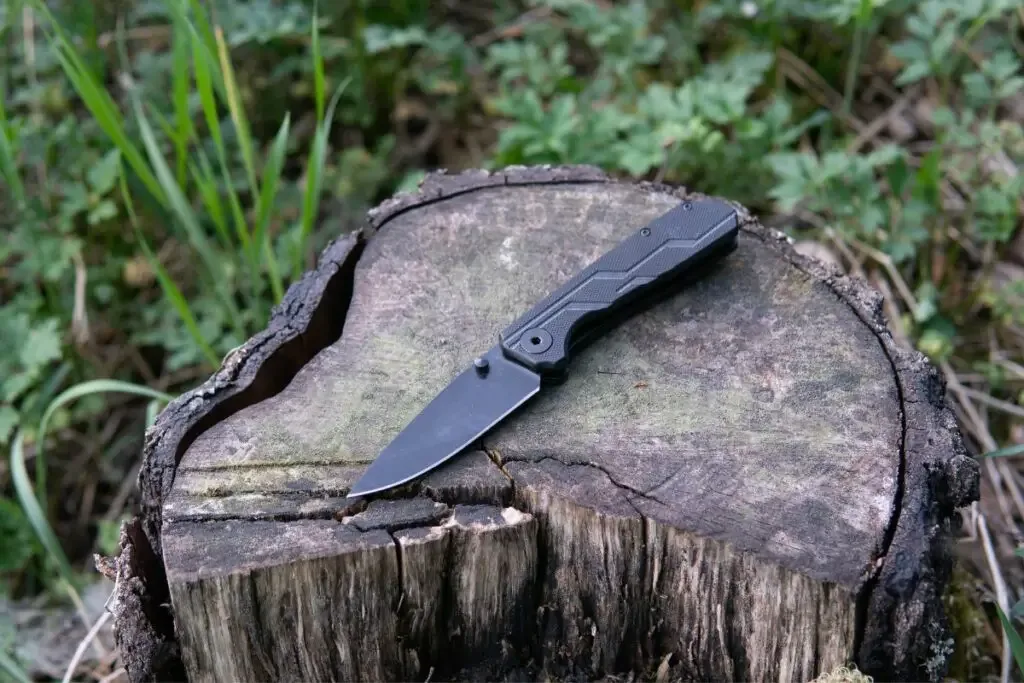
In the realm of everyday carry tools, the pocket knife reigns supreme for its versatility and utility. However, its effectiveness is heavily dependent on one crucial aspect: sharpness.
The article from Sharpy Knives underscores the importance of maintaining a sharp edge on your pocket knife, emphasizing that the method of sharpening, while varied, is secondary to the essential practice of ensuring the blade does not go dull.
A Sharp Knife Is a Safe Knife
The saying, “a sharp knife is a safe knife,” is not just a slice of wisdom; it’s a slice of reality. A dull knife requires more force to cut, which can lead to the knife slipping and potentially causing injury.
In contrast, a sharp knife requires less force, allowing for more control and precision with every cut. This control is paramount, as it minimizes the risk of the knife slipping or behaving unexpectedly and causing an accident.
Maintaining More Than Just the Edge
Sharpening your pocket knife is about more than just keeping a keen edge; it’s about maintaining the integrity of the tool itself. A sharp blade encounters less resistance, which means less wear and tear on both the blade and the handle.
Regular sharpening distributes the normal stress of use evenly across the blade, helping to preserve its shape and functionality.
The Lifespan of Your Blade
A well-maintained pocket knife can last a lifetime, and sharpening is a significant part of that maintenance. Sharpening your knife not only keeps it ready for immediate use but also ensures that it remains in good condition over time.
Allowing a knife to go dull can lead to improper cutting techniques, which can damage the blade and shorten its lifespan.
The Versatility of Sharpening Methods
The article from Sharpy Knives presents a variety of sharpening methods, from the traditional whetstone to more unconventional means like using a rock or sandpaper. This breadth of techniques highlights an important point: having a sharpening method that works for you is crucial.
If you find yourself without a conventional sharpening tool, improvising with an alternative method is always preferable to letting the knife’s edge wear down to dullness.
Whether you’re an outdoor enthusiast, a craftsman, or someone who appreciates the utility of a good pocket knife, keeping your blade sharp is a non-negotiable aspect of knife ownership. It ensures safety, prolongs the life of your knife, and guarantees that when you reach for your knife, it’s as ready to perform as you are.
Conclusion
Depending on your circumstances, there are many ways to sharpen a pocket knife. Putting a little thought into what the sharpening process does, you can develop a variety of alternative sharpening methods that we have not listed here.
If you have any fine abrasive surface, you can figure out a way to use it to sharpen your pocket knife. However, the best sharpening method still remains a good set of decent-quality whetstones!
TIP: Victorinox Swiss Army Knives are iconic knives, but there are some alternatives that rival the Swiss quality and reputation. Check them out in the article below:
Best Victorinox Swiss Army Knife Alternatives You Should Try
